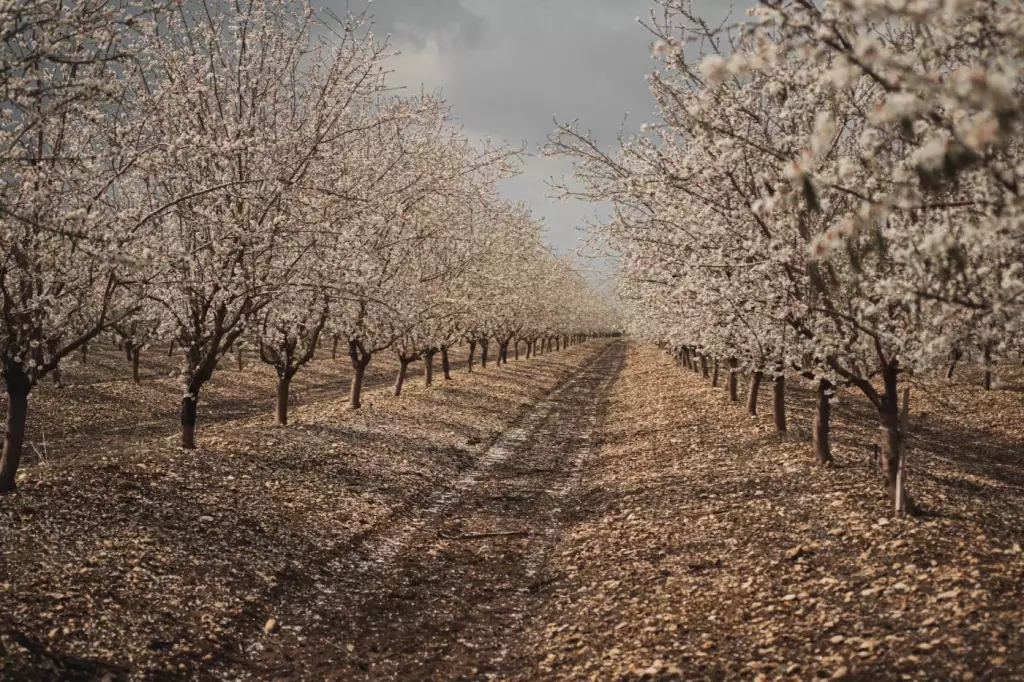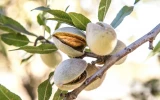Where Do Almond Trees Grow? (Best Growing Zone)
Almond cultivation requires very specific climate conditions to thrive and produce a nut crop. This article will help you determine if your location has the right growing conditions for almonds and provide all the information necessary to successfully cultivate these trees.
Almond trees thrive in areas with a Mediterranean climate, which includes regions with mild, wet winters and hot, dry summers. The best-growing zones for almond trees are typically USDA hardiness zones 7 to 9, which include parts of California, Southern Europe, North Africa, the Middle East, and other similar regions.
Almond trees are drought-tolerant and prefer low humidity. The perfect amount of annual rainfall for almond trees is approximately 20–25 inches, making them well-suited to semi-arid conditions. Let's take a closer look at the ideal conditions for almond trees' growth and development.
Summary
- USDA Zones 7-9 are considered the best zones to grow almonds as they have temperature ranges and climates that allow almond trees to thrive, with mild winters that meet their chilling requirements and long, hot summers needed for nut production.
- California is by far the largest and most important region for almond production worldwide, growing over 80% of global supply.
- Almond trees thrive in warm climates with temperatures between 50 and 86°F year-round, and they also need ample direct sunlight for 6–8 hours daily and can only tolerate light frosts.
- Almond trees thrive in loose, well-draining soils that have a neutral pH between 6.5 and 7.5 and sufficient nutrients.

On this page:
Best Growing Zones for Almond Trees
Below is a table showing the best growing zones for almond trees:
| USDA Zone | Temperature Range | Climate Description | Optimal for Almond Trees? |
|---|---|---|---|
| 7 | 10-40°F (-12 to 4°C) | Cold winters, warm summers. Low risk of frost. | Yes |
| 8 | 5-30°F (-15 to -1°C) | Cool winters, hot summers. Moderate risk of frost. | Yes |
| 9 | Above 10°F (-12°C) | Mild winters, very warm summers. Low risk of frost. | Yes |
| 6 or below | Below 10°F (-12°C) | Very cold winters, risk of frost. | No, too cold |
| 10 or above | Above 40°F (4°C) | Warm winters, hot summers. Risk of frost. | No, too warm |
Almond trees thrive in moderate climates with long, hot summers, and mild winters. They require well-drained soil with a pH range between 6.0 to 7.5 and full sun exposure for optimal growth and production.
The optimal growing zones for almond trees are USDA zones 7 through 9. These zones refer to the areas where specific environmental conditions are conducive to this type of tree cultivation. They are influenced by factors like temperature, rainfall, and winter chill hours.

In zone 7, the average minimum temperature is between 0°F and 10°F, while in zone 9, the average minimum temperature is between 20°F and 30°F.
Almond trees require a certain amount of cold to successfully produce nuts, around 200 to 500 "chill hours" per year at temperatures less than 45°F (7°C).
California's Central Valley is considered an almond-growing paradise, especially in USDA zones 9 and 10. In these zones, summers are hot and sunny, and winters get cold enough to meet most chilling requirements.
By February, frost leaves, and temperatures settle between 55° to 60°F (12.7° to 15.5°C). Winter rains taper off so bees pollinate undisturbed.
Common Growing Regions for Almond Trees
Almond trees are commercially cultivated in several regions around the world that provide optimal climatic and soil conditions. The table below shows the top producers, exporters, and cultivators of almond trees:
| Region | Top Producing Area(s) | Climate/Conditions | Estimated Annual Production (tons) |
|---|---|---|---|
| California, USA | Central Valley, Sacramento Valley, Imperial Valley | Hot, dry summers and mild, wet winters | 1,700,000 |
| Australia | New South Wales, Victoria, South Australia | Warm summers, cool winters | 70,000 |
| Spain | Andalusia, Valencia | Mild winters, hot summers | 160,000 |
| Italy | Sicily, Apulia, Calabria | Hot, arid summers, mild winters | 50,000 |
California is the largest almond producer worldwide
California is by far the largest producer of almonds in the world, growing over 80% of global supply. The Central Valley of California has a Mediterranean climate that is perfectly suited to almond cultivation, with hot, dry summers and mild, wet winters.
Major production areas include the San Joaquin Valley, Sacramento Valley, and Imperial Valley. Ideal growing conditions and advanced farming practices have allowed California's almond industry to thrive.
Australia is the second-largest almond producer globally
The majority of almonds in Australia are grown in the state of New South Wales, particularly the Riverina region which has warm summers and cool winters similar to California. Other production areas include Victoria and South Australia.
Australian almonds have gained popularity due to their large kernels and great taste. The climate is generally drier than traditional Mediterranean-growing regions.

Spain is a top exporter of almonds
Spain has a long history of almond cultivation in Mediterranean regions such as Andalusia and Valencia. Mild winters and hot, rainless summers provide excellent conditions for almond trees to grow and produce nuts.
Spain is one of the top exporters of almonds globally. The Valencia region in particular is known for its high-quality Marcona almonds.
Italy has a suitable climate for almond cultivation
Italy has ideal growing conditions for almonds across its southern regions. Major production areas include Sicily, Apulia, and Calabria.
The hot, arid summers and mild, wet winters are similar to other Mediterranean climates suitable for almond cultivation. Italian almonds have a prized flavor and are commonly used in confections, baked goods, and spreads like pistachio pesto.
If your region is included in these mentioned areas and you want to try cultivating almonds, you'll be surprised to know how profitable almond farming is.
Ideal Climate Conditions for Almond Trees
Almond trees require specific environmental conditions for optimal growth such as the following:
| Climate Requirement | Almond Trees Requirement |
|---|---|
| Temperature | Between 50-86°F year-round |
| Rainfall | Around 18 inches annually |
| Chilling Hours | 250-600 hours below 45°F in winter |
| Sun Exposure | 6-8 hours of direct sun daily |
| Frost Tolerance | Tolerates light frosts |
Temperature requirements for almond trees
Almond trees require warm temperatures to grow and produce fruit. They thrive in temperatures between -6 and 28.5°C. This warm weather allows for optimal flowering, nut formation, and kernel development. Temperatures that are too cool can delay or inhibit these growth stages.
The minimum winter temperature should not drop below -3°C, as this can cause frost damage to the tree. During the early spring, temperatures should be around 15°C, while in late winter, temperatures should be around 10°C.
Almond trees prefer low rainfall and humidity
Almond trees are drought-tolerant and prefer low humidity. The perfect amount of annual rainfall for almond trees is around 18 inches.

In regions with high humidity, the risk of fungal diseases increases, which can damage the tree and reduce fruit production.
Almond trees have a required chilling hours
Almond trees require between 250 to 600 chilling hours. Chilling hours are the number of hours below 7°C during the dormancy phase that encourage bud development. Once the buds have developed, they need to become dormant to survive the winter.
Almonds need ample sun exposure
Almonds need ample direct sunlight each day to maximize growth and production. They require a minimum of 6-8 hours of direct sun exposure
Insufficient sunlight can result in reduced flowering, nut set, and smaller almond kernels. Ideal orchards have open canopies to allow the sun to penetrate deep into the tree structure.
Almonds can only tolerate light frosts
Mature almond trees can tolerate light frosts down to around 25°F, but excessive freezing temperatures can damage the flowers, young leaves, and small nuts. This is why warmer zones 7-9 are optimal.
The trees also require a certain number of winter chill hours between 32-45°F for proper dormancy and flowering the following spring.
Soil Requirements When Growing Almond Trees
Almonds have specific preferences when it comes to the texture, composition, and moisture-retention abilities of the soil, as shown in the table below:
| Soil Requirements | Almond Trees Soil Requirement |
|---|---|
| Drainage | Loose, sandy loam for quick water permeation |
| pH | Neutral 6.5-7.5 for optimal nutrient availability |
| Nutrients | N, P, K, Ca, Mg plus micronutrients |
| Moisture Retention | Loamy soil retains moisture while allowing drainage |
They prefer well-draining soil
Almond trees need soil that drains well to prevent root rot from overwatering. The ideal soil texture is loose, sandy loam that allows excess water to permeate quickly without becoming soggy.
Soils that are heavy clay or compacted can lead to moisture issues and stunted growth. The type of soil where almonds are grown also determines the density of trees you can plant per acre.

They grow best in soils with neutral pH
Almonds grow best in soils with a neutral pH between 6.5-7.5. If the soil is too acidic or alkaline, essential nutrients may not be available to the trees. Maintaining the proper pH through amendments helps ensure optimal nutrient absorption.
They require nutrient-rich soils
The soil should have adequate levels of major and minor nutrients for robust tree development. Nitrogen, phosphorus, potassium, calcium, magnesium, and micronutrients like zinc and boron are important. Compost and fertilizers can be used to replenish nutrients removed through annual harvests.
They like soil with good moisture retention
While good drainage is critical, almond trees also need soil that retains some moisture to prevent drought stress. Loamy textures provide both drainage and water retention.
Regular irrigation and mulching help keep the root zone moist, especially in arid growing regions. Almonds are considered to be one of the best crops for dry farming in dry climate areas, as they rely on the conservation of soil moisture rather than irrigation to grow crops.
Knowing both the soil and climate condition requirements for almond trees allows you to maximize yield from each. To have an idea of the average almond yield per tree, you can read this article.



